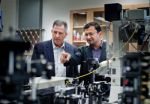(Press-News.org) Among more than 56,000 adults undergoing hip repair between 2004 and 2011, the use of regional anesthesia compared with general anesthesia was not associated with a lower risk of death at 30 days, but was associated with a modestly shorter length of hospital stay, according to a study in the June 25 issue of JAMA.
Each year, more than 300,000 hip fractures occur in the United States, which can lead to functional disability and death. Regional anesthesia for hip fracture surgery may reduce postoperative complications, and practice guidelines have called for broader use of regional anesthesia for hip fracture surgery, according to background information in the article.
Mark D. Neuman, M.D., M.Sc., of the Perelman School of Medicine at the University of Pennsylvania, Philadelphia, and colleagues assessed the association of regional (i.e., spinal or epidural) anesthesia vs general anesthesia with 30-day mortality and hospital length of stay after hip fracture surgery. The study included patients 50 years or older who were undergoing surgery for hip fracture at general acute care hospitals in New York State between July 2004 and December 2011.
Of 56,729 patients, 15,904 (28 percent) received regional anesthesia and 40,825 (72 percent) received general anesthesia. Overall, 3,032 patients (5.3 percent) died within 30 days of surgery. The researchers did not observe a statistically significant difference in mortality according to anesthesia technique. They did find that regional anesthesia was associated with approximately a half day shorter length of hospital stay.
"Our findings may have implications for clinical practice and health policy. Regional anesthesia is used as the primary anesthetic technique in a minority of hip fracture surgeries performed in the United States and in other countries, and increasing its use has been proposed as a strategy to improve the quality of hip fracture care. We found an association between greater use of regional anesthesia and a reduction in length of stay after hip fracture; however, we did not find regional anesthesia to be associated with statistically significant differences in mortality" the authors write.
INFORMATION:
"These findings do not support a mortality benefit for regional anesthesia in this setting.
(doi:10.1001/jama.2014.6499; Available pre-embargo to the media at http://media.jamanetwork.com)
Editor's Note: Please see the article for additional information, including other authors, author contributions and affiliations, financial disclosures, funding and support, etc.
Use of regional anesthesia during hip fracture surgery not linked with lower risk of death
2014-06-24
ELSE PRESS RELEASES FROM THIS DATE:
Stem cell transplantation for severe sclerosis associated with improved long-term survival
2014-06-24
Among patients with a severe, life-threatening type of sclerosis, treatment with hematopoietic stem cell transplantation (HSCT), compared to intravenous infusion of the chemotherapeutic drug cyclophosphamide, was associated with an increased treatment-related risk of death in the first year, but better long-term survival, according to a study in the June 25 issue of JAMA.
Systemic sclerosis is an autoimmune connective tissue disease characterized by vasculopathy (a disorder of the blood vessels), low-grade inflammation, and fibrosis (development of excess fibrous connective ...
3D mammography detects more invasive cancers and reduces call-back rates
2014-06-24
PHILADELPHIA—Reporting in the June 25 issue of JAMA, researchers from Penn Medicine and other institutions found that 3D mammography—known as digital breast tomosynthesis— found significantly more invasive, or potentially lethal, cancers than a traditional mammogram alone and reduced call-backs for additional imaging. This is the largest study reported to date—with nearly a half a million women—measuring the effectiveness of the technology, and could potentially lead to a change in the standard of care for breast screening.
"It's the most exciting improvement to mammography ...
3D Mammography finds more invasive cancers and reduces unnecessary recalls
2014-06-24
CLEVELAND – 3D Mammography finds significantly more invasive cancers and reduces unnecessary recalls, according to a large, retrospective study published in June 25 issue of the Journal of the American Medical Association (JAMA). The study features data from University Hospitals Case Medical Center Seidman Cancer Center.
The study, the largest of its kind, focused on the impact of 3D mammography at a diverse range of sites across the U.S, looking at nearly half a million mammograms at 13 sites.
Key Findings:
41% increase in invasive cancer detected with 3D mammography
15% ...
Chronic migraine has a substantial impact on marriage and parenting
2014-06-24
A web-based study of 994 men and women with chronic migraine found that the condition significantly impacts family relationships and activities, including cancelled vacation plans and reduced quality time with partners and children. Feelings of guilt, anger and annoyance toward family members due to headache, and avoidance of sexual intimacy due to headache also were reported. Chronic migraine is generally defined as migraine with headaches occurring 15 or more days per month.
The Family Burden of Chronic Migraine to the Migraineur: Results of the CaMEO (Chronic Migraine ...
Demonstrating a driverless future
2014-06-24
In the coming decades, we will likely commute to work and explore the countryside in autonomous, or driverless, cars capable of communicating with the roads they are traveling on. A convergence of technological innovations in embedded sensors, computer vision, artificial intelligence, control and automation, and computer processing power is making this feat a reality.
This week, researchers from Carnegie Mellon University (CMU) will mark a significant milestone, demonstrating one of the most advanced autonomous vehicles ever designed, capable of navigating on urban roads ...
Can coral save our oceans?
2014-06-24
Coral reefs are home to a rich and diverse ecosystem, providing a habitat for a wide range of marine animals. But the increasing acidification of ocean water is jeopardizing the calcified foundations of these reefs, endangering the survival of thousands upon thousands of resident species.
New research by Prof. Yehuda Benayahu, Dr. Zehava Barkay, Prof. Maoz Fine, and their jointly supervised graduate student Yasmin Gabay of Tel Aviv University's Department of Zoology, Wolfson Applied Materials Research Center and the Interuniversity Institute for Marine Sciences in Eilat ...
UT Arlington nanoparticles could provide easier route for cell therapy
2014-06-24
UT Arlington physics researchers may have developed a way to use laser technology to deliver drug and gene therapy at the cellular level without damaging surrounding tissue. The method eventually could help patients suffering from genetic conditions, cancers and neurological diseases.
In a study published recently by the journal Nature Scientific Reports, the team paired crystalline magnetic carbon nanoparticles and continuous wave near-infrared laser beams for in what is called photothermal delivery. Authors of the new paper are Ali Koymen, a professor of physics; Samarendra ...
How to protect an American wildlife legacy
2014-06-24
A new paper shows that while science plays a critical role in informing conservation action, scientists must move beyond the realm of their expertise into less familiar areas like public relations, education, and even politics, to ultimately meet America's conservation goals.
The paper, "Moving Beyond Science to Protect a Mammalian Migration Corridor," appears in the current online edition on the journal Conservation Biology, and will appear in Volume 28 of the print edition. Authors are Joel Berger of the Wildlife Conservation Society (WCS) and the University of Montana, ...
Group recommends removing sexual orientation-related disorders from the ICD
2014-06-24
A working group evaluating sexual orientation-related disorders listed in the International Classification of Diseases (ICD), a publication of the World Health Organization (WHO), has recommended the disorders be deleted, a move that will make getting health care easier for gays and others who may have gender atypicality.
The WHO is the world body charged with deciding what is a disease and more than 170 countries, including the United States, follow their recommendations. The organization is currently revising the 10th edition of the ICD for release of the 11th edition ...
UMMS scientists show that monarch butterflies employ a magnetic compass during migration
2014-06-24
WORCESTER, MA – Each fall millions of monarch butterflies use a sophisticated navigation system to transverse 2,000 miles from breeding sites across the eastern United States to an overwintering habitat in specific groves of fir trees in central Mexico. Scientists at the University of Massachusetts Medical School and Worcester Polytechnic Institute have identified a new component of this complex system. They reported in Nature Communications that monarchs use a light-dependent, inclination magnetic compass to help them orient southward during migration.
"Taken as a whole, ...




